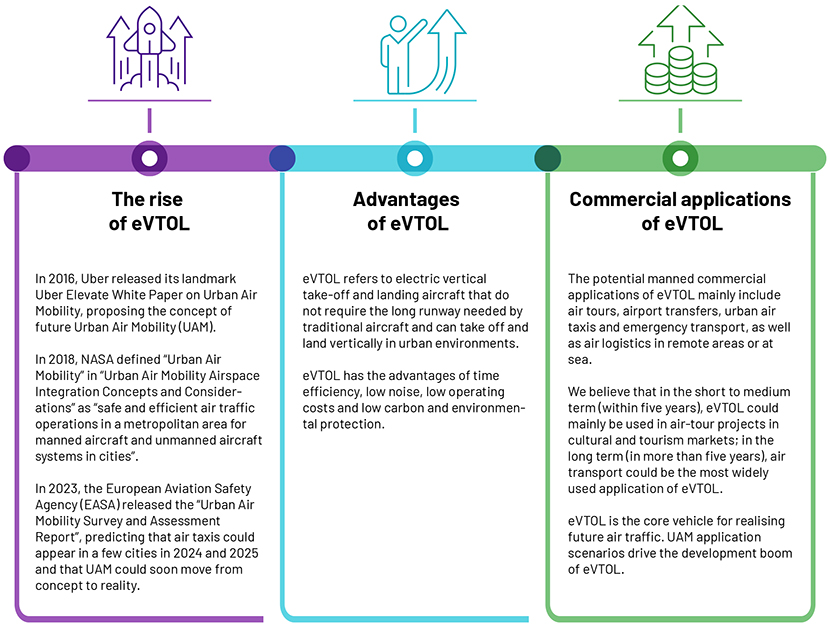Introduction
Introduction
With the rise of electric vertical takeoff and landing (eVTOL) technology, its advantages and application scenarios have gradually emerged and expanded in China. This article explains why eVTOL technology could, over time, lead China’s transport sector.

Extreme commuting in China needs urgent improvement, and eVTOL has a bright future.
What is the low-altitude economy?
The “low-altitude economy” refers to economic activities that take place in the airspace below 3,000 meters (3,280 feet) above the Earth’s surface. China is currently prioritising gradually opening up activity below 1,000 meters. The “low-altitude economy” can be regarded as an upgraded version of general aviation. The core lies in transforming the newly opened airspace resources into economic resources, supporting a number of industries.
China’s low-altitude economic market has broad prospects
China’s low-altitude economy is developing rapidly. The market was worth CNY505.95bn in 2023, growing 33.8% y/y, according to data from the Ministry of Industry and Information Technology. With the increase in low-altitude flight activity, low-altitude infrastructure investment is also increasing
Advantages of eVTOL – time efficiency, low operating costs, environmentally friendly
1. eVTOL has a significant advantage in terms of time efficiency
In the UAM scenario, eVTOL has a very significant time-efficiency advantage. Most eVTOLs are currently designed to cruise at a speed of about 200 kilometres per hour, much faster than the operating speed of about 40 kilometres per hour for ground transport. This could reduce the 45-minute commuting time on the ground to about 15 minutes. Combined with the ability of eVTOL aircraft to take off and land quickly and complete flight-state transitions quickly, this could effectively improve urban-transport efficiency.
2. Low operating costs
eVTOL is used in UAM application scenarios; operating costs mainly include energy, crew, maintenance, batteries, airports and capital costs. Due to the variety of eVTOL aircraft, pilots, aircraft loads and aircraft costs, different estimates of average daily operating hours and passenger load factors could affect the eVTOL operating cost calculation. At present, the ticket price is based on comprehensive operating costs, calculated by the operating company, including equipment depreciation and other operating costs, combined with reasonable profits.
A quite conservative assumption is that, without taking into account the potential efficiency benefits brought by economies of scale, the unit operating cost of an eVTOL aircraft is approximately CNY10-12 per seat per kilometre.
For a competitive cost structure, aircraft costs and operating costs could be reduced to one-tenth of the original. There are already players in the market that could reduce the unit operating cost to approximately CNY3.6 per kilometre. A single aircraft could fly approximately 20 kilometres within five minutes, with a single seat costing around CNY60, which translates into CNY3 per kilometre. There could still be a 30-40% decline in the future.
3. eVTOL is green and environmentally friendly and conforms to carbon peaking and carbon neutrality goal
eVTOL is a green and environmentally friendly aircraft that is fully electric and has no carbon emissions or direct carbon emissions. eVTOL can reduce traffic congestion and dependence on fossil fuels in cities, in line with the trend of carbon neutrality and carbon peaking in aviation transport. The green and environmentally friendly performance of eVTOL is mainly reflected in the distributed electric propulsion (DEP) system and noise reduction technology that use new energy applications. The advantage of eVTOL’s low noise could enable it to fly to the community centre as much as possible, extending the operating time and distance of eVTOL in the city.
Conclusion
While these new aircraft can lead to many benefits, it does not guarantee that their services would be fundamentally accepted by society. A number of stakeholders must work together to communicate with the public to ensure that these services are understood, accepted and even needed by citizens. Only in this way could the true “market-driven” approach be effectively implemented and the infinite possibilities of three-dimensional transport be truly opened up.
How Acuity Knowledge Partners can help
We help clients stay ahead of the curve by adopting innovative and sustainable business models and taking first-mover advantage of market opportunities available in China’s eVTOL sector. Sector experts at our Beijing office work with our clients’ strategy, business development, market intelligence and M&A teams, supporting them with critical insights.




